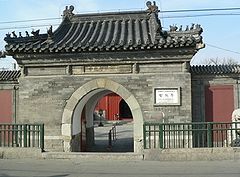
Zhihua Si Temple
Encyclopedia

Ming Dynasty
The Ming Dynasty, also Empire of the Great Ming, was the ruling dynasty of China from 1368 to 1644, following the collapse of the Mongol-led Yuan Dynasty. The Ming, "one of the greatest eras of orderly government and social stability in human history", was the last dynasty in China ruled by ethnic...
-era Buddhist
Buddhism
Buddhism is a religion and philosophy encompassing a variety of traditions, beliefs and practices, largely based on teachings attributed to Siddhartha Gautama, commonly known as the Buddha . The Buddha lived and taught in the northeastern Indian subcontinent some time between the 6th and 4th...
temple in Beijing
Beijing
Beijing , also known as Peking , is the capital of the People's Republic of China and one of the most populous cities in the world, with a population of 19,612,368 as of 2010. The city is the country's political, cultural, and educational center, and home to the headquarters for most of China's...
, China
China
Chinese civilization may refer to:* China for more general discussion of the country.* Chinese culture* Greater China, the transnational community of ethnic Chinese.* History of China* Sinosphere, the area historically affected by Chinese culture...
. It is located in the Lumicang (禄米仓) hutong
Hutong
Hutongs are a type of narrow streets or alleys, most commonly associated with Beijing, China.In Beijing, hutongs are alleys formed by lines of siheyuan, traditional courtyard residences. Many neighbourhoods were formed by joining one siheyuan to another to form a hutong, and then joining one...
, in the Chaoyangmen
Chaoyangmen
Chaoyangmen is the name of a gate in the former city wall of Beijing. It is now a transportation node and a district border in Beijing. It is located in the Dongcheng District of northeastern central Beijing....
area of the Dongcheng District
Dongcheng District, Beijing
Dongcheng District is an urban district in Beijing covering the eastern half of Beijing's urban core. It is 24.7 square kilometres in area and has a population of 535,558 . Dongcheng District covers several important parts of Beijing...
, within the Second Ring Road
2nd Ring Road (Beijing)
Encircling the centre of Beijing, the 2nd Ring Road is just a few kilometres away from the city centre and is a convenient alternative road to avoid congestion there. One can divide the road into two parts: the original ring road , and the newly extended ring road...
to the north of Jinbaojie Street, west of the Yabaolu area. The temple was built in 1443 at the order of Wang Zhen
Wang Zhen (eunuch)
Wáng Zhèn was the first Ming Dynasty eunuch with power in the court. The Zhihua Si Temple in Beijing was built in 1443 at his order.He was killed during the Tumu Crisis , a disastrous campaign against the Oirat Mongols for which he was responsible.- External links :*...
, a powerful eunuch in the Rites Supervising Office of the court of the Zhengtong Emperor
Zhengtong Emperor
Zhu Qizhen was an emperor of the Ming Dynasty. He ruled as the Zhengtong Emperor from 1435 to 1449, and as the Tianshun Emperor from 1457 to 1464....
(also known as Yingzong; reigned 1436-1449 and 1457-1464).
The temple, surrounding buildings, and grounds comprise approximately 20 thousand square meters. It is one of the most important original building complexes from the Ming Dynasty period in the Old City area, and one of the only wooden structures and groups of buildings from the Ming Dynasty to remain intact in Beijing. It is also striking for its extensive use of black roof tiles. The Beijing Cultural Exchange Museum, established in November 1992, is located in the temple compound; its principal aim is "as a centre for developing cultural exchange and for developing the study of cultural relics and museums."
At the temple, a group of musicians regularly performs centuries-old ritual music which has been handed down over 27 generations. The six-member group is led by the octogenarian Buddhist monk Zhang Benxing (张本兴, born c. 1922), the only surviving member of the 26th generation of musicians, and the last person to have learned the music in the traditional manner. In addition to singing voices, the instruments used include guanzi
Guan (instrument)
The guan is a Chinese double reed wind instrument. The northern Chinese version is called guanzi or bili and the Cantonese version is called houguan . It is classified as a bamboo instrument in the Ba Yin system...
(oboe), dizi (bamboo flute), sheng
Sheng (instrument)
The Chinese sheng is a mouth-blown free reed instrument consisting of vertical pipes.Traditionally, the sheng has been used as an accompaniment instrument for solo suona or dizi performances. It is one of the main instruments in kunqu and some other forms of Chinese opera...
(mouth organ), yunluo
Yunluo
The yunluo is a traditional Chinese musical instrument. It was also called yún'áo in ancient times....
(a set of ten small tuned gongs mounted vertically in a frame), and percussion including drums and cymbals.
The Zhihua Temple became a nationally preserved cultural and historic relic in 1961. In 2005 the Chinese government undertook a renovation of the temple (which is now complete) in preparation for the numerous international visitors expected at the time of the 2008 Summer Olympics
2008 Summer Olympics
The 2008 Summer Olympics, officially known as the Games of the XXIX Olympiad, was a major international multi-sport event that took place in Beijing, China, from August 8 to August 24, 2008. A total of 11,028 athletes from 204 National Olympic Committees competed in 28 sports and 302 events...
.

